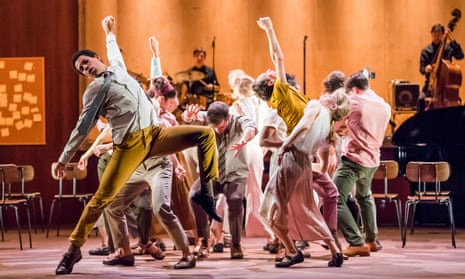What does it mean when dancers express emotion on stage? Do they bring real-life experiences to those highly choreographed moments when they’re leaping with ecstasy, racked by grief or, as in the climax of Stravinsky’s Rite of Spring, dancing themselves to death on behalf of a fearful, threatened community? These are some of the questions posed by Goat, the raw, funny and occasionally searing new piece of dance theatre that Ben Duke has made for Rambert.
The setting is an ambiguous space that is part meeting hall, part performance arena, and its “characters” are a group of dancers and musicians who have gathered to enact some kind of cathartic emotional ritual. Miguel Altunaga plays a reporter sent to describe it, and the tone at first is wickedly funny as Altunaga – a pitch perfect combination of intrusive and bewildered – tries to make sense of what’s happening. “Amazing energy,” he pronounces as the group rock through a happy-clappy ensemble. Then as the group divide into individual solos, contorting their bodies into expressions of private feeling, he trails after the dancers, hoping for elucidation. One of them, her limbs tied into an agonised knot, explains breathlessly that she’s dancing about the “stigma of addiction”. Another, his eyes rolling back in his head with exertion, says he’s expressing a sense of betrayal.
It’s a brilliant riff on the worst cliches of interpretative modern dance but Duke is soon flipping the work into something deeper, darker and more personal. His inspiration for Goat came from watching footage of Nina Simone, who, legendarily, appeared to suffer and exult through every emotion of every song she sang. Duke has replicated some of that rare intensity on his stage by having the marvellous Nia Lynn performing some of Simone’s best-known repertory. The richness of Lynn’s range, from the celebratory Ain’t Got No, I Got Life to the ineffably bleak Ballad of Hollis Brown, brings a thrilling emotional charge, even to Duke’s more overtly comic material.

The second half of Goat is framed directly around the scenario of Stravinsky’s Rite and it is here that the work begins to posit its teasing and surprisingly affecting relationship between the passions of the real world and the choreography on stage. Once the group have prepared their victim, Liam Francis, for sacrifice, one of them delivers a fraught, furious speech listing all the evils – from killing seals to asbestos poisoning – that his death is intended to purge. When Altunaga shoves his microphone at Francis, the doomed man can barely talk and his fate comes to seem even more vivid to us when, after his solo “dance to the death”, Hannah Rudd takes his broken body in her arms and delivers a heartrending monologue about losing a lover in a recent terrorist attack. By the time Lynn closes the work with a wrenching rendition of Feelings, we’re in an emotional no man’s land, unsure where artifice begins or ends.
Goat is a precariously poised work, playing with a multitude of ideas. The fact that it comes across as coherently as it does is due to the exceptional skills of its cast, who make even the deliberately fake look somehow transparently true. That onstage honesty is deeply refreshing and it casts an interesting light on the two works that precede Goat in the programme.

Itzik Galili’s A Linha Curva is an unabashed street party of a dance, inspired by the music and movement of Brazil. Galili is clever in how he concentrates the exuberance of his material through the strictness of his geometric structure, and Rambert’s dancers who’ve been performing the work since 2009 are exemplary in combining Latin-inflected sass with meticulous speed. Hips swivel, feet drum, bodies skid and slide. But the work falters, for me, when Galili attempts to channel actual street life into the choreography and especially when the male dancers, hopped up on testosterone, compete to outdance and outflirt each other. It is harmless fun, but the language is predictable verging on trite.
Even the superb dancers of Rambert cannot give much credibility to Symbiosis, a work created by the Greek choreographer Andonis Foniadakis. Set to a commissioned score by Ilan Eshkeri, the choreography is, according to Foniadakis, inspired by the pattern and behaviours of city life. But the relentlessness of the dance material – every phrase revved up to head-tossing, leg-flicking levels of hyperactivity – resists any kind of emotional, musical or narrative logic. If Altunaga’s character wandered in from Goat to ask the dancers what they were meant to be doing, I’m not convinced any of them would be able to answer.
- At Sadler’s Wells, London, until Saturday. Box office: 020-7863 8000.

Comments (…)
Sign in or create your Guardian account to join the discussion